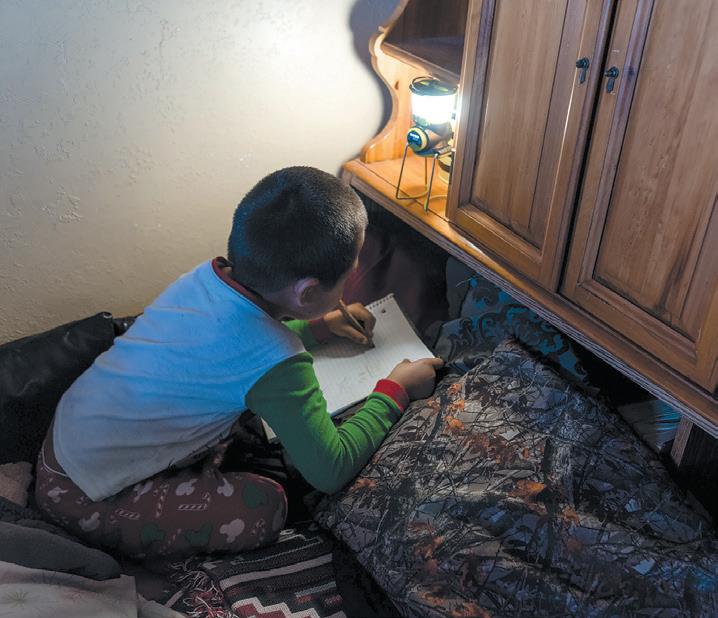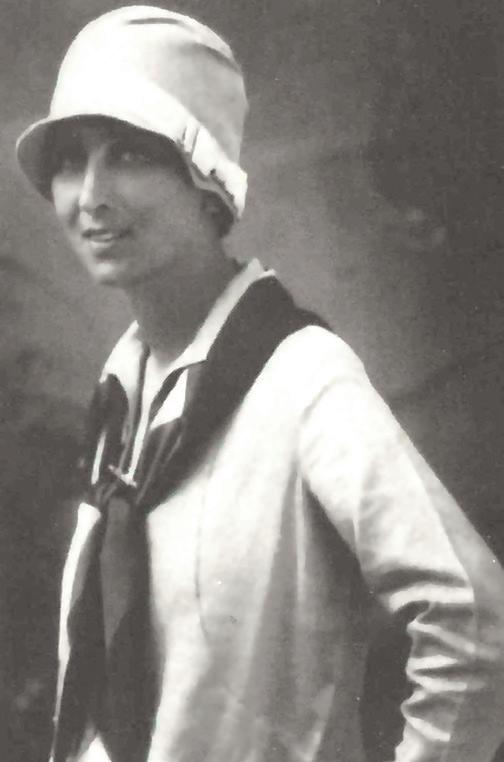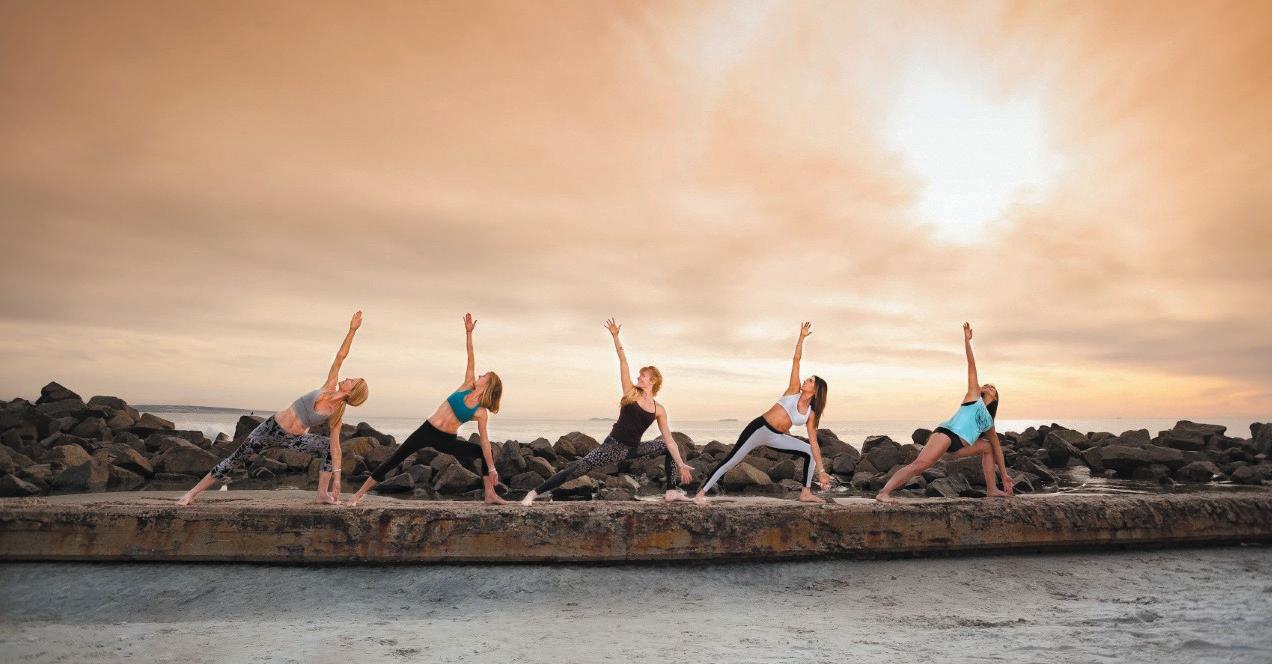
5 minute read
Bringing Electricity to Navajo Land
POWERED UP
Project shines light on Navajo electricity needs
Advertisement
Hogans, built with materials harvested from the land, provide housing for about 25% of Navajo people who live on their ancestral lands.
Story by MARK RAFFERTY Photos by BRIAN DOLL
Imagine life without electricity – without television, computers, tablets, video games or cell phones; where refrigerators don’t exist and where running water, showers and plumbing are non-existent. For approximately 15,000 Navajo Nation families this is reality. With four people in an average household, this equates to roughly 60,000 people. These numbers represent nearly 75% of all the households without electricity in the entire United States.
The need for electricity is great in the Navajo Nation, but so is the price of materials and labor to connect homes to the grid. As such, it is often cost-prohibitive for utility companies to provide services to individual homes on much of the Navajo land. To connect each home is a daunting goal that requires innovative solutions. One of these initiatives is the “Light Up Navajo” campaign.
San Diego’s Swinerton Renewable Energy was approached by the Navajo Tribal Utility Association (NTUA) to participate in the campaign. In October 2018, Swinerton Renewable Energy was awarded the 28-megawatt Kayenta II project in Arizona, part of Kayenta Solar Project, the first large scale solar facility on Navajo land and the largest tribally owned renewable power plants in the country.
“Telling this story is very important to me because people should know, and they should act. We take power for granted. Can you imagine a world with no light

For a one-time installation cost of $400, solar energy eliminates buying kerosene and batteries for power, saving money for other important needs. Before he got a portable light, Bear (above) tucked a flashlight under his chin for lighting.

where you chase the sun every day to read your newspaper, do your homework, read a book before bed?” said Jennifer Hershman, a Coronado resident and the community relations coordinator at Swinerton.
To date, Swinerton and their site partners have donated a total of $33,000 to Light Up Navajo. These funds will be used to extend electricity to homes for the very first time. Swinerton has teamed up with NTUA’s renewable energy specialist, Derrick Terry, who is partnering with Swinerton and Utah-based Goal Zero for a solar lighting project throughout the Navajo Nation called “The Lightmakers Project.”
Goal Zero is a private company that provides portable power sources that can charge a variety of devices without being connected to the grid. The project is starting with 10 homes. All labor is donated.
“My role with this particular project was initiated through our marketing team who brought me the idea after watching the Honnold Foundation’s video called Share the Sun. Once I saw the video, I knew we had to get involved,” Hershman said.
Hershman and coworker Brian Doll attended the Navajo Sustainability Symposium last April to learn about the Navajo Nation and meet Terry. Discussions with Terry included installing the portable systems and how to connect with the people who needed the systems. The Navajo call themselves Diné, which means The People. Their creation stories tell of struggle and evolution through three spiritual worlds and finally emergence into this world and their present homeland, Dinétah, which
Volunteers from Light Up Navajo install solar panels in preparation to give this home its first electricity. The most recent Light Up Navajo 3 project installed electricity for 13 military veterans in New Mexico.

is defined by four sacred mountains: Mount Blanca in central Colorado, Mount Taylor in New Mexico, the San Francisco Peaks in Arizona and Mount Hesperus in southwestern Colorado. Navajo Nation is the largest Native American reservation in the United States, covering 25,000 square miles—roughly the size of Maine. “The land, the people really affected me personally in a quest to solve an issue that in reality is pretty easy,” Hershman said.
After the symposium the team headed to Monument Valley to see the Kayenta site. There they met with a young Diné woman named Mariah who returned to her homeland after graduating from college. She is currently working on the Kayenta site and invited Hershman Coronado resident Jennifer Hershman gives instructions on how to use the portable power source.

Mariah's hogan (also pictured on page 36) is outfitted with traditional materials and modern-day comforts.

and Doll into her home to so they can better understand the Navajo way of life.
Mariah lives in a hogan (pronounced hogawn), a traditional dwelling made with materials harvested from the land. It is completely sustainable and off the grid. About 25% of the 190,000 Navajos who live on their ancestral land live in hogans. Many of these homes are in very remote areas; homesteads where their families have lived for generations.
The traditional economy is based upon farming and livestock. Families often live on large parcels of land, creating significant distances between neighboring homes. Because of this, Navajo Nation
For information on how to assist the Navajo Nation in their needs for electricity, visit gofundme.com/light-upthe-navajonation.
has the lowest number of utility customers per square mile in the United States.
Sean Begay, a Navajo and senior project engineer at Kayenta, grew up near Monument Valley. He sees first-hand how the work has impacted his community, not only through job creation, but also through the Swinerton jobsite crew’s ongoing participation in
area clean-ups and food donations at the senior center.
He sees solar energy as a way for the Diné to protect and give back to Mother Earth, in line with traditional Navajo teaching.
In all, 32% of Navajo Nation homes lack electricity and 86% of them lack natural gas. To compensate, many families use kerosene lanterns or rigged car batteries for their power source. The emissions from kerosene and batteries cause many health issues including asthma, cataracts, heart disease, strokes and lung cancer.
“Now that I know what I know, I can’t un-know it. So that is why I will be forever dedicated to this effort,” Hershman said.












